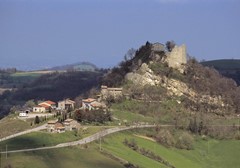Municipality of Canossa.
The legend of Canossa and the ruins of the castle
We begin our journey from a legendary place that has gone down in history thanks to an event of extraordinary importance: Canossa, where the remains of the mighty castle of the Magna Comitissa Matilda loom over the valleys and surrounding high ground. It is the year 1076 and we find ourselves in the thick of the Struggle over investiture between Pope Gregory VII and the Emperor Henry IV. At any cost, the pope wants to avoid the power to nominate bishops from remaining in the hands of the sovereign and consequently resorts to his most powerful weapon to discredit Henry: Excommunication.
Gregory issues the edict and immediately sets off for Germany with Matilda, but is then warned that Henry is coming down into Italy with his army. As a result Matilda forces Gregory to take shelter in her impregnable fortress of Canossa, where, in January 1077 Henry arrives too, this time without any notion of waging war, but with the desire to beg his greatest enemy for pardon.
On arriving at the foot of the castle, the Emperor takes off his furs that protected him from the deadly chill gripping those terrible winter days, dons a simple tunic and remains for three days, and probably three nights, between the third and second circle of walls before being received by the Pope. From the top of the rock the gaze takes in the vast horizon which, on the clearest days, extends as far as the sweep of the Alps. Legend has it that the first castle was built during the first half of the X century, by request of Sigifredo da Lucca, led to the site by a doe whilst out hunting. What is certain is that in 950 Queen Adelaide sought shelter in the castle while fleeing from Berengarius, King of the Lombards.
In the same period, Atto Adalberto, Sigifredo’s son spent a large part of his riches to transform the castle into a proper fortress. Also the church dedicated to the martyr St. Apollonius was built at this time, to house some reliquaries of the Saint, stolen from Brescia by Atto himself. However it was under Matilda that the fortress of Canossa reached its greatest splendour. The surveys and excavations made from 1878 onwards and the descriptions by Friar Donizone, Matilda’s biographer, allow us to make a fairly faithful reconstruction of the castle of which only some traces of the southern wall and the crypt of the church of St. Apollonius are all that remain.
Defence was ensured by three encircling walls, inside which sat the village dwellings at the foot of the fortress, along with the soldiers' quarters, the stables and the storerooms. The access road was two metres wide and extremely steep. There were three gates: at the foot, through the second set of walls, and at the summit. The latter remains, as part of the surviving walls. The fortalice complex was reached through a small courtyard which led to the parade ground where, on the right, sat the nobleman’s palace surrounded by other residential buildings. On the south side of the palace was the entrance to the church through a vestibulum, as well as the monastery with cells for the monks to sleep. The palace was situated in the centre protected by the keep, roughly where the “Naborre Campanini” museum now sits. This museum is home to a collection of several finds that came to light during nineteenth-century excavations, including a striking monolithic sandstone baptismal font from the XII century. To be seen in the Church of St. Apollonius are some extraordinary bas-relief decorations depicting the traditional symbols of the evangelists, an allegorical representation of Good and Evil framed by a crown with interwoven floral motifs. The first room houses a splendid model showing the castle in its original form, from which we can understand just how magnificent the medieval structure was.
It is worthwhile lingering for a while in the village lying below the mighty mass of the castle which, although containing very few ancient buildings, gives a good idea of what a medieval castle village looked like. From the castle it is possible to continue our visit, on foot or by car, to other charming nearby villages with a medieval layout. To Riverzana, where there is a fine tower house, or Grassano, arguably the most interesting of the villages near Matilda’s castle. Constructional elements belonging to different epochs, from the late Middle Ages to the Renaissance, emerge on the façades of the older buildings. Of note is the ancient tower house with an uninterrupted view of the castles of Canossa and Rossena.
Just 3km from Canossa the small medieval village of Votigno is home to the “House of Tibet” and a Tibet Museum opened by the Dalai Lama in person in 1990. Famous internationally, the House seeks to spread Tibetan culture and fosters dialogue between the cultures and religions of the world.
